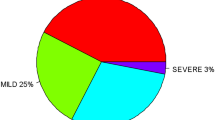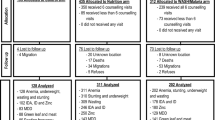Abstract
Objective:
Anemia is a serious public health problem in Indian school children. Since 2003, simple health intervention programs such as antihelminthic treatment and vitamin A supplementation have been implemented in primary schools in the Bangalore region, Karnataka, India. This study examines the prevalence of anemia in school children who are beneficiaries of this program.
Design:
Cross-sectional survey.
Setting:
Bangalore district, South India.
Subjects:
A total of 2030 boys and girls, aged 5–15 years, attending schools in the Bangalore district.
Interventions:
School-based, twice yearly intervention: deworming (albendazole 400 mg, single oral dose) and vitamin A supplementation (200 000 IU, single oral dose).
Main outcome measures:
Anemia prevalence based on measure of blood hemoglobin (Hb).
Results:
Mean age and blood Hb concentration of all children were 9.5±2.6 years and 12.6±1.1 g/dl (range 5.6–16.7), respectively. The overall anemia prevalence in this group was 13.6%. Anemia prevalence was lower in boys than girls (12.0%; n=1037 vs 15.3%; n=993 respectively, P<0.05). There was no significant difference in anemia prevalence between children in urban and rural locations (14.6 and 12.3%, respectively).
Conclusions:
The current low anemia prevalence in Bangalore could be due to the impact of school-based intervention programs that have been in place since 2003. The beneficial interactions of deworming and vitamin A supplementation could have widespread implications for current preventive public health initiatives. There is now need for the development of clear policy guidelines based on these simple and integrated interventions.
Sponsorship:
This research was supported by the Micronutrient Initiative, Ottawa, Canada, and Unilever Food and Health Research Institute, Vlaardingen, The Netherlands.
This is a preview of subscription content, access via your institution
Access options
Subscribe to this journal
Receive 12 print issues and online access
$259.00 per year
only $21.58 per issue
Buy this article
- Purchase on Springer Link
- Instant access to full article PDF
Prices may be subject to local taxes which are calculated during checkout

Similar content being viewed by others
References
Akshara Dasoha (2003). To the children of all Government Primary School in the State, Government Order No. ED 24 MMS 2003. In: office of the Joint Director of Public Instruction (Midday Meal Scheme). Government of Karnataka, India, Karnataka.
Bhargava A, Jukes M, Lambo J, Kihamia CM, Lorri W, Nokes C et al. (2003). Anthelmintic treatment improves the hemoglobin and serum ferritin concentrations of Tanzanian schoolchildren. Food Nutr Bull 24, 332–342.
Bloem MW, Wedel M, Egger RJ, Speek AJ, Schrijver J, Saowakontha S et al. (1989). Iron metabolism and vitamin A deficiency in children in northeast Thailand. Am J Clin Nutr 50, 332–338.
Dreyfuss ML, Stoltzfus RJ, Shrestha JB, Pradhan EK, LeClerq SC, Khatry SK et al. (2000). Hookworms, malaria and vitamin A deficiency contribute to anemia and iron deficiency among pregnant women in the plains of Nepal. J Nutrit 130, 2527–2536.
Dwivedi SN, Banerjee N, Yadav OP (1992). Malnutrition among children in an urban Indian slum and its associations. Indian J Matern Child Health 3, 79–81.
Gilgen D, Mascie-Taylor CG (2001). The effect of anthelminthic treatment on helminth infection and anaemia. Parasitology 122 (Pt 1), 105–110.
Gomber S, Bhawna, Madan N, Lal A, Kela K (2003). Prevalence & etiology of nutritional anaemia among school children of urban slums. Indian J Med Res 118, 167–171.
Kapil U, Saxena N, Srivastava M, Jailkhani L, Nayyar B, Chitkara P (1996). Assessment of vitamin A deficiency indicators in urban slum communities of National Capital Territory of Delhi. Asia Pacific J Clin Nutr 5, 170–172.
Khandait DW, Vasudeo ND, Zodpey SP, Ambadekar NN, Koram MR (1999). Vitamin A intake and xerophthalmia among Indian children. Public Health 113, 69–72.
Kumar CS, Kumar AH, Sunita V, Kapur I (2003). Prevalence of anemia and worm infestation in school going girls at Gulbarga, Karnataka. Indian Pediatr 40, 70–72.
Mejia LA, Chew F (1988). Hematological effect of supplementing anemic children with vitamin A alone and in combination with iron. Am J Clin Nutr 48, 595–600.
Mohanram M, Kulkarni KA, Reddy V (1977). Hematological studies in vitamin A deficient children. Int J Vitam Nutr Res 47, 389–393.
Mwanri L, Worsley A, Ryan P, Masika J (2000). Supplemental vitamin A improves anemia and growth in anemic school children in Tanzania. J Nutr 130, 2691–2696.
NFHS-2 (1998-99). National Family Health Survey II. In: IIPS, Mumbai, India.
Rao B (2003). Anaemia and micronutrient deficiency. The National Med J India 16, 46–50.
Semba RD, Bloem MW (2002). The anemia of vitamin A deficiency: epidemiology and pathogenesis. Eur J Clin Nutr 56, 271–281.
Seshadri S (1996). A data base on iron deficiency anaemia (IDA) in India: Prevalence, aetiology, consequences and strategies for control. Prepared for Task Force on Micronutrient Malnutrition Control. In: Department of Women and Child Development, Ministry of Human Resources Development., New Delhi.
Sethi V, Goindi G, Kapil U (2003). Prevalence of anemia amongst primary school age children (6–11 years) in National Capital Territory of Delhi. Indian J Pediatr 70, 519–520.
Stoltzfus RJ, Chway HM, Montresor A, Tielsch JM, Jape JK, Albonico M et al. (2004). Low dose daily iron supplementation improves iron status and appetite but not anemia, whereas quarterly anthelminthic treatment improves growth, appetite and anemia in Zanzibari preschool children. J Nutr 134, 348–356.
Stoltzfus RJ, Dreyfuss ML, Chwaya HM, Albonico M (1997). Hookworm control as a strategy to prevent iron deficiency. Nutr Rev 55, 223–232.
Sur D, Saha DR, Manna B, Rajendran K, Bhattacharya SK (2005). Periodic deworming with albendazole and its impact on growth status and diarrhoeal incidence among children in an urban slum of India. Trans R Soc Trop Med Hyg 99, 261–267.
Tanumihardjo SA, Permaesih D, Muhilal (2004). Vitamin A status and hemoglobin concentrations are improved in Indonesian children with vitamin A and deworming interventions. Eur J Clin Nutr 58, 1223–1230.
UNICEF (2001). National Report-Multiple Indicator Cluster Survey-2. In: Department of Women and Child Development, Government of India and United Nations Children's Fund (UNICEF), New Delhi.
WHO (2001). Iron deficiency anemia: Assesment prevention and control-A guide for program manager In: NHD01.3 ed, WHO: Geneva.
Wolde-Gebriel Z, West CE, Gebru H, Tadesse AS, Fisseha T, Gabre P et al. (1993). Interrelationship between vitamin A, iodine and iron status in schoolchildren in Shoa Region, central Ethiopia. Br J Nutr 70, 593–607.
Zimmermann M, Biebinger R, Rohner R, Dib A, Zeder C, Hurrell RF et al. (2006). Vitamin A supplementation in children with poor vitamin A and iron status increases erythropoietin and hemoglobin concentrations without changing total body iron. Am J Clin Nutr 84, 580–586.
Acknowledgements
The assistance of Dr R Goud, Dr D Moretti, Ms A Vani and Ms L Sebastian is gratefully acknowledged. We thank Mr T M Vijay Bhaskar, Secretary, Department of Education, Government of Karnataka, the Departments of Health and Women and Child Development, Government of Karnataka, for their support and cooperation.
Author information
Authors and Affiliations
Corresponding author
Additional information
Guarantor: S Muthayya.
Contributors: SM, PT, MBZ and MA were involved in study design and implementation, data interpretation and writing of the manuscript. DM and AE were involved in study design, implementation and revising of the manuscript. AVK and RFH were involved in study design, data interpretation and writing of the manuscript. The authors have no conflict of interest.
Rights and permissions
About this article
Cite this article
Muthayya, S., Thankachan, P., Zimmermann, M. et al. Low anemia prevalence in school-aged children in Bangalore, South India: possible effect of school health initiatives. Eur J Clin Nutr 61, 865–869 (2007). https://doi.org/10.1038/sj.ejcn.1602613
Received:
Revised:
Accepted:
Published:
Issue Date:
DOI: https://doi.org/10.1038/sj.ejcn.1602613
Keywords
This article is cited by
-
The gender gap among school children in poor rural areas of western China: evidence from a multi-province dataset
International Journal for Equity in Health (2016)
-
Prevalence of asymptomatic malaria infection and use of different malaria control measures among primary school children in Morogoro Municipality, Tanzania
Malaria Journal (2015)
-
The effect of a 1-year multiple micronutrient or n-3 fatty acid fortified food intervention on morbidity in Indian school children
European Journal of Clinical Nutrition (2012)
-
The prevalence and etiology of anemia among HIV-infected children in India
European Journal of Pediatrics (2012)



